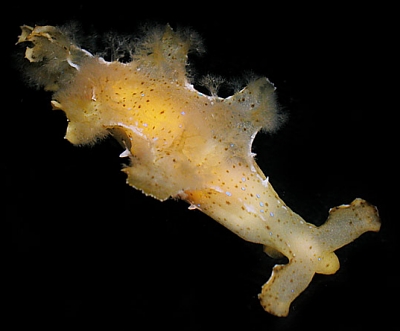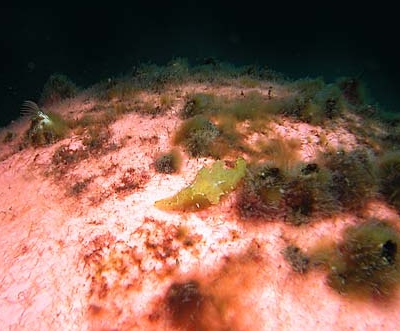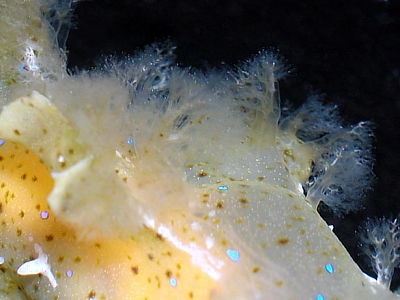Re: Scyllaea pelagica? from sthn Queensland
October 16, 2008
From: Gary Cobb


Concerning message #14049:
Hi Bill and everyone!
I thought you might like to add an addition to your list from southern Queensland. This animal was found after a dive on the HMAS Brisbane, during our safety stop I noticed this critter on the mooring buoy just before we were to ascend!! SCORE!
Locality: Mooloolaba, Sunshine Coast, 5 m, Queensland, Australia, Pacific Ocean, 27 January 2006, Subtidal. Length: 50 mm. Photographer: Gary Cobb.
Cheers
Gary
gary@nudibranch.com.au
Cobb, G.C., 2008 (Oct 16) Re: Scyllaea pelagica? from sthn Queensland. [Message in] Sea Slug Forum. Australian Museum, Sydney. Available from http://www.seaslugforum.net/find/21939
Dear Gary,
Every time I see one of these fascinating animals I get more confused trying to identify them to the genus level. There are really no external features to separate Scyllaea and Notobryon. Internally, Scyllaea differs in having a central tooth in the radula, while Notobryon does not. My feeling is that this is probably Notobryon wardi which was described from Queensland, Australia. It doesn't help that it was described from preserved animals so we have no idea of the colour or living shape of the original specimens.
At present Scyllaea, as represented by S. pelagica, can be identified externally by the dark brown band along the side of the body, just below the mantle edge. On those grounds I think I would rather identify your animal as Notobryon. Of course the only way to be sure is to look at its radula. Whatever it is, it is a wonderful find. One of the reasons we have trouble with this group is that Scyllaea pelagica appears to be the only species which is regularly encountered. This is because it lives on floating weeds and often washes ashore after storms. If it were not for the radular difference, I would suggest we consider Scyllaea and Notobryon to be one genus, but until we have many more specimens - preferably with photographs or drawings of them alive - we won't be able to get past the impasse created by Odhner's study of preserved animals many years ago.
-
Odhner, N.H. (1936) Nudibranchia Dendronotacea - A revision of the system. Mémoires du Musee Royal d'Histoire Naturelle de Belgique, series 2, fasc. 3, 1057-1128. (Pl. 1)
Best wishes,
Bill Rudman
Related messages
-
Notobryon ? from nthn Mariana Islands
From: Takao Urasawa, April 17, 2008 -
Notobryon wardi - caprellid symbiosis?
From: Guido Zsilavecz, July 13, 2007 -
Radula of Notobryon wardi
From: Bill Rudman, September 14, 2002 -
Notobryon wardi? from Mexico
From: Ali Hermosillo, September 14, 2002 -
Notobryon wardi? from west Mexico
From: Alicia Hermosillo, June 29, 2002 -
Notobryon from Hong Kong
From: Bernard Picton , May 23, 2002 -
Scyllaeidae from Bahia de Banderas, (2)
From: Alicia Hermosillo, May 18, 2002 -
Notobryon wardi from the Philippines
From: Erwin Koehler, August 9, 2001 -
Notobryon bijercurum or bijecurum?
From: Pauline Fiene-Severns, July 24, 2000 -
Notobryon wardi at Fly Point, Port Stephens
From: Ron Greer, May 30, 2000
